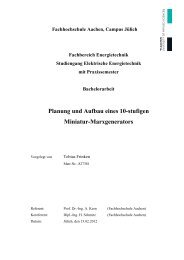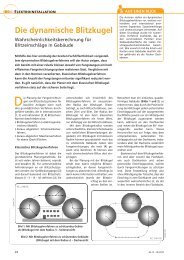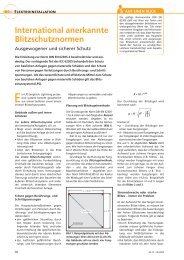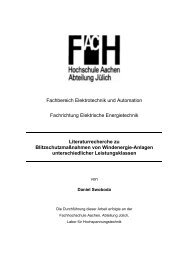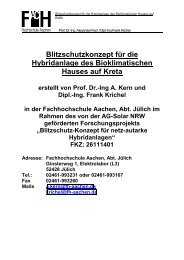Simulation of electric and magnetic fields using FEMM - FH Aachen ...
Simulation of electric and magnetic fields using FEMM - FH Aachen ...
Simulation of electric and magnetic fields using FEMM - FH Aachen ...
You also want an ePaper? Increase the reach of your titles
YUMPU automatically turns print PDFs into web optimized ePapers that Google loves.
1. Electrostatics<br />
What is Electrostatics?<br />
Electrostatics is the study <strong>of</strong> time-independent distributions <strong>of</strong> charges <strong>and</strong> <strong>fields</strong>.<br />
It is a branch <strong>of</strong> science that deals with the phenomena arising from stationary or<br />
slow-moving <strong>electric</strong> charges.Electrostatic phenomena arise from the forces that <strong>electric</strong><br />
charges exert on each other. 2<br />
Electrostatics contains some problems like properties analyzing in capacitors <strong>and</strong> in some<br />
containers. No current is involved in Electrostatics.<br />
1.1 Cable 1<br />
Assume we have a perfect concentric copper cable. At inner cable a voltage <strong>of</strong> 130kV<br />
(compare to the ground) is applied. (relative permittivity <strong>of</strong> copper εr≈ 1)<br />
Layer 1 Layer 2<br />
εr 3 2<br />
Table 1-1 Values <strong>of</strong> the relative permittivityεr<br />
We will analyze the curve E=f(r) <strong>of</strong> this cable <strong>and</strong> draw a plot <strong>of</strong> E=f(r).<br />
1.1.1 Create a new file.<br />
“File”→“New”→ “Electrostatics Problem”<br />
Figure 1-1 Create a new problem dialogue box<br />
1.1.2 Set problem definition.<br />
Press Menu: “Problem”.<br />
Figure 1-2 Problem definition dialogue box<br />
2 《Electrostatics: Theory <strong>and</strong> Applications》 by Camille L. Bertr<strong>and</strong>




